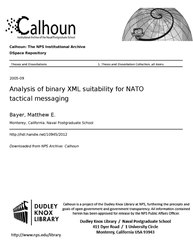File:Analysis of binary XML suitability for NATO tactical messaging (IA analysisofbinary109452012).pdf

Original file (1,275 × 1,650 pixels, file size: 3.4 MB, MIME type: application/pdf, 130 pages)
Captions
Captions
Summary[edit]
| Analysis of binary XML suitability for NATO tactical messaging
( |
||
|---|---|---|
| Author |
Bayer, Matthew E. |
|
| Title |
Analysis of binary XML suitability for NATO tactical messaging |
|
| Publisher |
Monterey, California. Naval Postgraduate School |
|
| Description |
The ability to efficiently transfer information among tactical systems is essential for network-centric operations. However, maintaining interoperability among heterogeneous networks and applications is a challenging issue, especially for large enterprises such as the US Department of Defense and NATO. Each of these organizations maintain extensive communication networks of tactical systems that process and manage all types of data. Additional complexity is added when considering that many systems are built with a variety of proprietary or legacy data formats. Establishing and maintaining interoperability is difficult. Using XML, many interoperability issues can now be successfully addressed. XML provides a self-describing way to effectively structure information that can be applied to compose diverse tactical communications. However, XML is inefficient for network transmission since it uses a text-based format which can consume more memory (and thus more bandwidth) than binary equivalents. In addition, parsing text-based documents is slow and computationally expensive. One potential solution is to use GZIP to reduce the file size before transmission. Unfortunately, this solution has limitations since it often provides suboptimal compression and also requires additional processing time when extracting data. Recent standardization efforts have identified promising new encodings for XML that use binary representations to reduce parsing time, memory size, and bandwidth requirements. This thesis surveys conversion of NATO tactical data link information into an XML format for distribution to command and control centers. General benefits and tradeoffs are then considered for applying binary XML encoding to that data. This thesis also examines work done by the World Wide Web Consortium in examining common use cases and developing the requirements needed for a binary XML encoding. The performance of two specific implementations, XML Schema based Binary Compression (XSBC) and Fast Infoset (FI) are compared with GZIP. XML files of varying sizes are encoded in binary form, then compression ratios and parsing times are compared and analyzed. Initial results are excellent and further work is recommended. Subjects: |
|
| Language | English | |
| Publication date | September 2005 | |
| Current location |
IA Collections: navalpostgraduateschoollibrary; fedlink |
|
| Accession number |
analysisofbinary109452012 |
|
| Source | ||
| Permission (Reusing this file) |
|
|
Licensing[edit]
| Public domainPublic domainfalsefalse |
This work is in the public domain in the United States because it is a work prepared by an officer or employee of the United States Government as part of that person’s official duties under the terms of Title 17, Chapter 1, Section 105 of the US Code.
Note: This only applies to original works of the Federal Government and not to the work of any individual U.S. state, territory, commonwealth, county, municipality, or any other subdivision. This template also does not apply to postage stamp designs published by the United States Postal Service since 1978. (See § 313.6(C)(1) of Compendium of U.S. Copyright Office Practices). It also does not apply to certain US coins; see The US Mint Terms of Use.
|
 | |
| This file has been identified as being free of known restrictions under copyright law, including all related and neighboring rights. | ||
https://creativecommons.org/publicdomain/mark/1.0/PDMCreative Commons Public Domain Mark 1.0falsefalse
File history
Click on a date/time to view the file as it appeared at that time.
| Date/Time | Thumbnail | Dimensions | User | Comment | |
|---|---|---|---|---|---|
| current | 06:14, 14 July 2020 |  | 1,275 × 1,650, 130 pages (3.4 MB) | Fæ (talk | contribs) | FEDLINK - United States Federal Collection analysisofbinary109452012 (User talk:Fæ/IA books#Fork8) (batch 1993-2020 #6303) |
You cannot overwrite this file.
File usage on Commons
The following page uses this file:
Metadata
This file contains additional information such as Exif metadata which may have been added by the digital camera, scanner, or software program used to create or digitize it. If the file has been modified from its original state, some details such as the timestamp may not fully reflect those of the original file. The timestamp is only as accurate as the clock in the camera, and it may be completely wrong.
| Author | NSharrock |
|---|---|
| Short title |
|
| Date and time of digitizing | 21:31, 26 October 2005 |
| File change date and time | 07:50, 1 November 2005 |
| Date metadata was last modified | 07:50, 1 November 2005 |
| Software used | PScript5.dll Version 5.2 |
| Conversion program | Acrobat Distiller 5.0.5 (Windows) |
| Encrypted | no |
| Page size | 612 x 792 pts (letter) |
| Version of PDF format | 1.4 |

